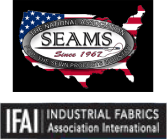Latest Posts
- Part 1 of 4 Series - Bow to Stern: Metal and Plastic Hardware Posted: 3/20/2019
- FR Treatments Explained Posted: 3/20/2019
- What is a DWR Treatment? Posted: 3/20/2019
- What Is Elastic and When Should You Use It? Posted: 3/20/2019
- Hook and Loop for Orthotics and Prosthetics Posted: 3/20/2019
Industrial Sewing Thread - Material, Construction, and FAQ
Posted: 3/1/2018
By: Collin Barnwell

Industrial sewing thread can be a small component of the manufacturing process, but the importance of having the correct thread is undeniable. Whether you’re manufacturing pet accessories or sewing together bimini boat tops and covers; choosing the correct thread with the correct properties is essential to the life and sustainability of your products.
Industrial Thread Material: Nylon or Polyester
While DirecTex offers various sewing thread materials, we specialize in nylon and polyester coned sewing thread. Nylon industrial thread offers a high strength-to-size ratio, flexibility, and stretch. Nylon threads do not perform well when exposed to outdoor conditions and prolonged UV exposure. Flexibility and high tensile strength makes nylon thread ideal for indoor upholstery applications and sewing together heavy-weight materials. Industrial polyester thread offers low shrinkage and stretch while retaining the strength and durability. Polyester thread is lighter weight than nylon, and treated with extra UV resistance making polyester thread the idea choice for sails, boat covers, awnings, tents, tarps, and outdoor upholstery and cushions. Polyester thread is also the number one choice for bonding together lighter weight fabrics.
Industrial Thread Construction: Bonded or Core Spun
The construction of industrial threads allows for endless opportunities to combine materials with different constructions. While we offer various construction types, DirecTex stocks two main constructions - bonded and core spun. Bonded thread indicates that the outside of the thread has been coated with a strength-enhancing resin. Bonded thread is approximately 5% thicker and reduced needle heat and fraying in production. Core Spun thread consists of a thread material surrounded by either polyester or cotton staple fibers to make the thread have a softer feel.
Below is a list of various questions we have received over the years about our industrial sewing thread.
I use V - 69 thread, how do I find what tex size that is? Thread is measured by three common sizing systems: tex, denier, and commercial. Commercial sizes are used for heavy-duty applications such as heavyweight upholstery, marine canvases, and webbing applications. Here is a chart showing how commercial sizes match-up with tex and denier sizes:
| COMMERCIAL | TEX | DENIER |
| V - 69 | 70 | 690 |
| V - 92 | 90 | 920 |
| V - 138 | 135 | 1,380 |
Other rolled goods are ordered in yards, why is thread measured in weight? Industrial sewing thread is measured by weight as different tex sizes result in thicker or thinner thread. The thinner the thread, the more yards per cone. Measuring by weight ensures a standard cone size across various tex sizes (8oz cones, 16oz cones, 24oz cones).
What are the benefits to using bonded polyester? Bonded polyester is a high-strength thread with little flexibility. Bonded Polyester is great for applications where UV resistance and strength is of concern. Available in various tex sizes, bonded polyester is widely used in outdoor products; specifically marine boat covers and bimini tops.




